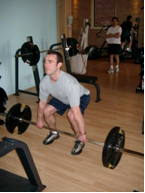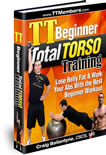Simultaneously Build Muscle and Lose Fat
 Last day, Nick Nilsson aka The Mad Scientist, shared with us his nutrition tips for those wanting to gain muscle as well as for those wanting to lose fat.
Last day, Nick Nilsson aka The Mad Scientist, shared with us his nutrition tips for those wanting to gain muscle as well as for those wanting to lose fat.
Today, however, we learn a Nilssonized version of my interval training methods! As well, for those of you wanting to build muscle AND lose fat at the same time, you’ll definitely want to hear what Nilsson has to share.
Let’s get at it….
************************
Craig Ballantyne: We’re probably going to have people listening that really want to gain muscle and lose fat at the same time, so what approach would you take?
Nick Nilsson: With that kind of approach actually I’ve found that it’s better not to try to do both of those goals exactly at once, because they’re very much COMPETING GOALS. To build muscle you need an excess of calories, and to lose fat you need just slightly below maintenance in order to lose fat.
What I tend to recommend to people is to do short cycles of both back to back….
…Similar to what I was just describing with the muscle building program, except you’re doing five days of a very low calorie and low carb diet (if you don’t want to do a low carb you don’t have to). Focusing your training on fat loss.
Then you turn around and do five days of just the opposite. For muscle building training, you eat a very high calorie load diet. Then just go back and forth between those two things every five days. I’ve seen some really incredible results with that.
Even though you’re not doing both goals at the exact same time, over the course of a month you are achieving that. You’re achieving muscle growth and you’re achieving fat loss at the same time.
Craig Ballantyne: Do you have a specific program for that or do you just use two different programs of yours?
Nick Nilsson: I do actually have on my site www.FitStep.com, you can go there and get the program for free. Simply sign up for the newsletter.
Craig Ballantyne: What’s it called?
Nick Nilsson: It’s My Dirty Little Secret Program.
Craig Ballantyne: Okay, great. We’ll have to check that one out.
Nick Nilsson: It’s a really powerful little program. I actually used it last year and got my HIGHEST DEADLIFT EVER by doing it. I managed to get up to 565 pounds off the deadlift on that.
Craig Ballantyne: Wow.
Nick Nilsson: Keeping the body fat below eight percent, so it was a pretty good program.
Craig Ballantyne: Seriously. So, let’s talk about deadlift then for a second. What were some of the things that you used in that deadlift program that helped you get up there? Did you add anything else; do you have any weird variations of deadlift that you use? 
Nick Nilsson: The weird thing with using that program; I actually wasn’t doing any heavy deadlifts at all. I was doing five days of muscle building; with very high rep and moderate weight with my deadlifts.
On the first round through the muscle building, I started with 225 lbs and did as many reps as I could. I think I did about 20 reps with that. Then the following round I think I put 275 lbs on and did 24 reps with it. So, it was more weight and increasing reps, then the following week I did 315 lbs for 30 reps.
I figured, “I feel pretty strong with this. Let’s try a max deadlift.” I managed to boost my max deadlift by about 20 pounds just by doing high rep moderate weight training like that, which was really surprising to me.
Craig Ballantyne: That’s extremely impressive, very impressive numbers. That’s pretty interesting stuff. What about interval training? Do you use that with clients, and do you use it more with women than men to help people lose fat, or are you using mostly just resistance training?
Nick Nilsson: The focus of my fat loss programs is generally going to be the resistance training, but I do include a lot of interval training when people do want to do cardio, simply because it’s MORE EFFECTIVE. The long duration stuff, I’ve found, can lead to a lot of boredom, and it can lead to repetitive stress injury and that keeps you out of the game.
I used to be a long distance runner myself, so I’m talking from experience there. Basically, I got injured more doing long distance running over a couple of years than I have over 18 years of weight lifting. I’m just not a big fan of the long duration kind of aerobic training, but it’s not all bad. You can do it for fun if you want to, but for fat loss…
…I definitely recommend the intervals.
When you think intervals, some people think that it has to be all hill sprints until you throw up. It doesn’t have to be like that. You can do more moderate paced intervals as long as you’re basically throwing your body for a loop and not doing the steady state it’s going to be more effective than that long term cardio.
Craig Ballantyne: Are you using any specific methods? Do you like a bike, or do you like people to get outside and run hill, what are you looking for there? Do you have any type of weird stuff that you use?
Nick Nilsson: Oh, I’ve got some very weird stuff that I use, without a doubt. I tend to like people to get outside and move. Machines are not all bad, I have a treadmill and a bike in my basement, and I use them in the winter, especially, but nothing beats getting out there and actually moving yourself around.
One of my FAVORITE techniques I like to do is I take a stopwatch with me and I go for a walk. I walk five seconds and then I do a fast 95 percent power sprint for 15 seconds. Then the watch goes off and I do five more seconds of walking, then 15 more seconds of running. I keep doing that for about 20 minutes.
What that does is it basically allows your body to work at a very high percentage of your maximum heart rate for long periods of time. Nothing gets me leaner than doing that when I’m doing a low carb training especially. It just kicks your metabolism like nothing else.
Craig Ballantyne: That’s similar to 20 seconds on and 20 seconds off, but you’re Nilssonizing it to 15 seconds on and five seconds off.
Nick Nilsson: Yes. It’s basically right along that line. I’ve done that before and it’s brutal too. This is not quite that intense, but it’s for a longer duration. It basically allows you to work at that higher level for longer periods and really push yourself.
 Craig Ballantyne: Very nice. Anything you’d like to add on fat loss?
Craig Ballantyne: Very nice. Anything you’d like to add on fat loss?
Nick Nilsson: Yes, actually. One more trick that I like to do for the interval training is to take a kettlebell for a run. Basically, you’re doing interval training with this, 30 seconds on and 30 seconds off, but you’re carrying a 25 pound kettlebell around the neighborhood doing that.
Not only does that give you a little extra resistance, it actually really hits your core strongly, because you’re just carrying it in one hand and then you switch hands on the next round.
Craig Ballantyne: Hold it off to the side?
Nick Nilsson: Yes. Just holding it to your side and running with this kettlebell beside you. Your neighbors will think you’re crazy.
Craig Ballantyne: It doesn’t hit your legs when you’re doing that?
Nick Nilsson: It doesn’t hit your legs at all actually. You just kind of hold it a little bit to the side. I’ve found that because the kettlebell has a little weight your body kind of tends to lean to that side anyway, so it does keep it away from your legs.
Craig Ballantyne: So, you’re going to alternate between you do one rep and then switch?
Nick Nilsson: Yes. You hold in the right hand for part of it and then the left hand for the next round, then the right hand, and go back and forth and hope that your neighbors don’t think you’re stealing something because you’re running.
Craig Ballantyne: Your neighbors must think you’re insane.
Nick Nilsson: My neighbors really do, because I’m running around carrying stuff and pushing things and pushing cars around and flipping tires out in the driveway and stuff.
Craig Ballantyne: Very nice. That’s pretty interesting. While we’re on the kettlebell tell me, what do you do with the kettlebell that’s different from what someone might learn in a regular kettlebell course?
Nick Nilsson: Honestly, not a whole lot. I haven’t really worked with kettlebells a whole lot. I’ve only got a couple in my basement. But, I don’t really do a whole different kind of thing with them other than that.
If you’re struggling with upper body exercise due to old injury’s then you will want to jump forward to part 4. Here Nick Nilsson gives a few exercises that will not aggravate your old shoulder injuries.